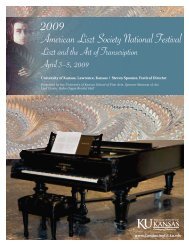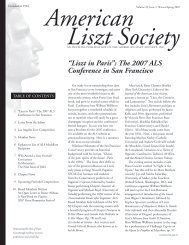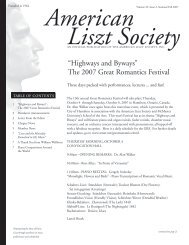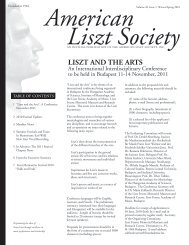Los Angeles International Liszt Competition an Incredible Event
Los Angeles International Liszt Competition an Incredible Event
Los Angeles International Liszt Competition an Incredible Event
You also want an ePaper? Increase the reach of your titles
YUMPU automatically turns print PDFs into web optimized ePapers that Google loves.
William Wright <strong>an</strong>d his recent <strong>Liszt</strong> discovery:<br />
the Hérold-Herz-<strong>Liszt</strong> Cavatine de Zampa<br />
William Wright, of Glasgow, Scotl<strong>an</strong>d,<br />
submitted the following information<br />
concerning his recent discovery of a work by<br />
<strong>Liszt</strong>.<br />
In July 2002 while I was accessing research<br />
data from the internet I happened to<br />
enter the “Albert Schweitzer - Gunsbach”<br />
website. The following description of items<br />
exhibited at the House Museum arrested my<br />
attention.<br />
“ In the former living room is Schweitzer’s<br />
pi<strong>an</strong>o fitted with org<strong>an</strong> pedals on<br />
which he played for forty-eight years<br />
in Lamberéné. It was a gift from the<br />
Paris Bach Society. He received it in<br />
1912, as a reward <strong>an</strong>d in gratitude for<br />
the m<strong>an</strong>y years during which he acted<br />
as org<strong>an</strong>ist to the Society . . . On the<br />
walls are photographs of his parents<br />
<strong>an</strong>d friends, concert programmes, [<strong>an</strong>d]<br />
<strong>an</strong> autograph of Fr<strong>an</strong>z <strong>Liszt</strong> offered to<br />
Albert Schweitzer . . . in 1949. “<br />
After a careful examination of the<br />
photocopied two-page keyboard m<strong>an</strong>uscript<br />
[the “autograph” referred to above], kindly<br />
sent to my address in late July 2002 by<br />
Sonja Poteau, Director of the Gunsbach<br />
Museum, it soon became clear to me that<br />
<strong>Liszt</strong> wrote the measures during his stay in<br />
Paris in the early eighteen thirties. There<br />
were no calligraphic notational difficulties.<br />
Even so, a word scrawled at the top of the<br />
first autograph page that resembled the<br />
Sp<strong>an</strong>ish word for “bagpipes” appeared<br />
problematic. I am most grateful to my<br />
colleague, Pauline Pocknell, who came to<br />
my aid with the suggestion that the elusive<br />
word might be “Zampa,” a suggestion that<br />
led me to seek out a pi<strong>an</strong>o reduction of<br />
Hérold’s opera Zampa. from the Glasgow<br />
University music library.<br />
An initial scrutiny of the score of the<br />
three act opera, set to a tale of a wicked<br />
pirate who seduces then ab<strong>an</strong>dons a<br />
Sicili<strong>an</strong> lady before being seized by her<br />
ghost <strong>an</strong>d dragged into the abyss, seemed<br />
unpromising. Nothing in the Overture or<br />
in Act One bore the slightest resembl<strong>an</strong>ce<br />
to the Schweitzer double-page m<strong>an</strong>uscript.<br />
However, the opening measures of the<br />
“Cavatine” at the beginning of Act Two<br />
appeared strikingly reminiscent of the<br />
opening “Finale” measures on page one of<br />
Schweitzer’s Zampa autograph.<br />
In July 2002 the possibility of the rest of the<br />
piece coming into my h<strong>an</strong>ds seemed remote.<br />
Where would I look Certainly not in the<br />
same library. But that is precisely where I<br />
found it 20 months later.<br />
After ab<strong>an</strong>doning all hope of locating a<br />
Zampa pi<strong>an</strong>o paraphrase in <strong>Liszt</strong>’s h<strong>an</strong>d, I<br />
beg<strong>an</strong> to investigate the library’s collection<br />
of keyboard works from the Paris Early<br />
Rom<strong>an</strong>tic Virtuoso School: works that<br />
<strong>Liszt</strong> would have studied, taught, <strong>an</strong>d<br />
performed in the French capital in the late<br />
eighteen twenties <strong>an</strong>d early thirties, works<br />
by Kalkbrenner, Hérold, Herz, Bertini, <strong>an</strong>d<br />
others.<br />
In March 2004, the tenth of March to be<br />
precise, a charming piece by Hérold from<br />
the collection caught my attention: his<br />
And<strong>an</strong>te et Rondeau for pi<strong>an</strong>o on a “Zampa”<br />
motif. I became even more interested when<br />
I discovered that the opening measures of<br />
the Rondo were the initial bars of the Zampa<br />
“Cavatine” in Act Two of the opera. That<br />
discovery led me to look for arr<strong>an</strong>gements<br />
on the same theme by other composers. The<br />
only other available arr<strong>an</strong>gement happened<br />
to be a Hérold-Herz Cavatine de Zampa, Op.<br />
66, for pi<strong>an</strong>o, one of just three copies then<br />
known to be held in Britain.<br />
It soon became clear that the Schweitzer<br />
Zampa double-page autograph was a<br />
<strong>Liszt</strong>i<strong>an</strong> correction sheet <strong>an</strong>d contained<br />
editorial material used by him when<br />
performing the keyboard Hérold-Herz.<br />
<strong>Liszt</strong> tastefully furnished the Hérold-Herz<br />
pi<strong>an</strong>o piece with embellishments <strong>an</strong>d minor<br />
melodic deviations before performing it<br />
in Paris around 1832. The tr<strong>an</strong>scription is<br />
based on the cavatine, “Il faut céder à mes<br />
lois et comment s’en défendre,” found at<br />
the beginning of the second act of Hérold’s<br />
Zampa, <strong>an</strong> opera premiered to great acclaim<br />
on 3 May 1831 at the Opéra Comique in<br />
Paris.<br />
This charming early Rom<strong>an</strong>tic keyboard<br />
composition, with introduction, theme,<br />
five variations <strong>an</strong>d rondo finale, exhibits<br />
fascinating features of the young Hungari<strong>an</strong><br />
composer’s editorial skills. The piece is based<br />
on the following three sources:<br />
1. a two-page Zampa autograph located at<br />
the Schweitzer Museum, Gunsbach, Alsace;<br />
2. a copy of the Hérold-Herz Cavatine de<br />
Zampa, op. 66, published by “les fils de B.<br />
Schott, Mayence et Anvers” (plate number<br />
3679), held in the British Library, London;<br />
3. a copy of the Hérold-Herz Cavatine<br />
de Zampa, op. 66, published ca. 1833<br />
by Goulding <strong>an</strong>d D’Almaine, London,<br />
located at the University Library, Glasgow,<br />
Scotl<strong>an</strong>d;<br />
I gave the first modern perform<strong>an</strong>ce of the<br />
uncatalogued Hérold-Herz-<strong>Liszt</strong> Cavatine de<br />
Zampa at a public concert held in McMaster<br />
University, Hamilton, Ontario, on 7<br />
October 2004, the opening day of the 10th<br />
Great Rom<strong>an</strong>tics Festival. Justin Kolb will<br />
perform the work at the 2005 <strong>Liszt</strong> Festival<br />
in Lincoln, Nebraska.<br />
10 Americ<strong>an</strong> <strong>Liszt</strong> Society








